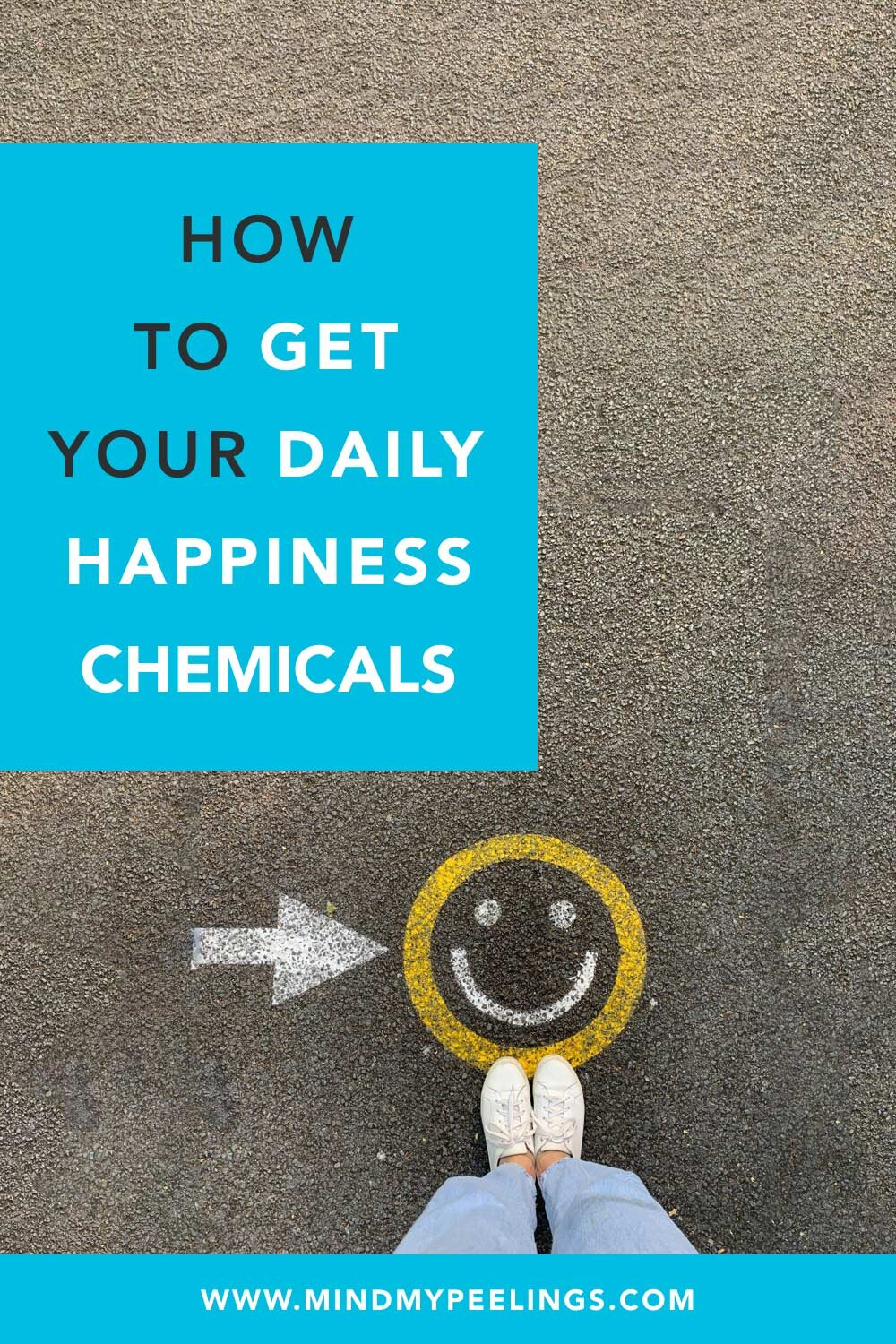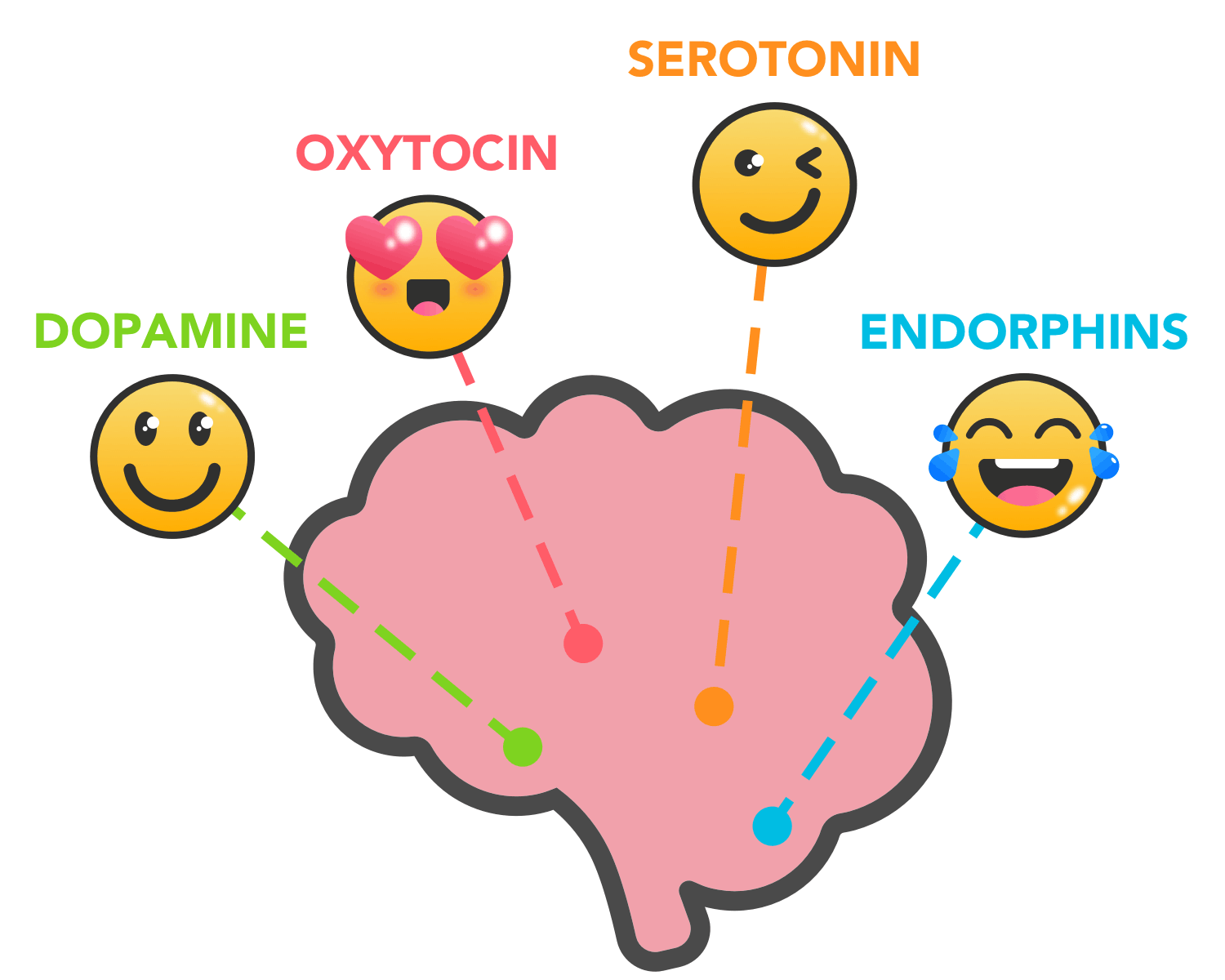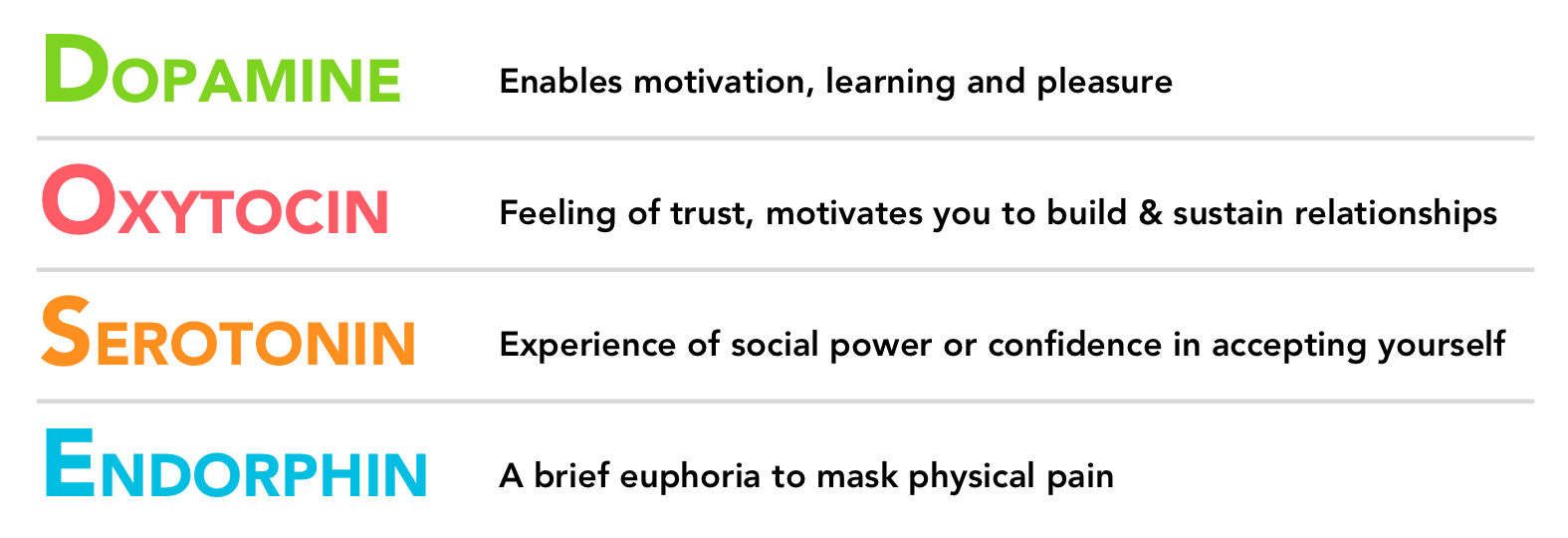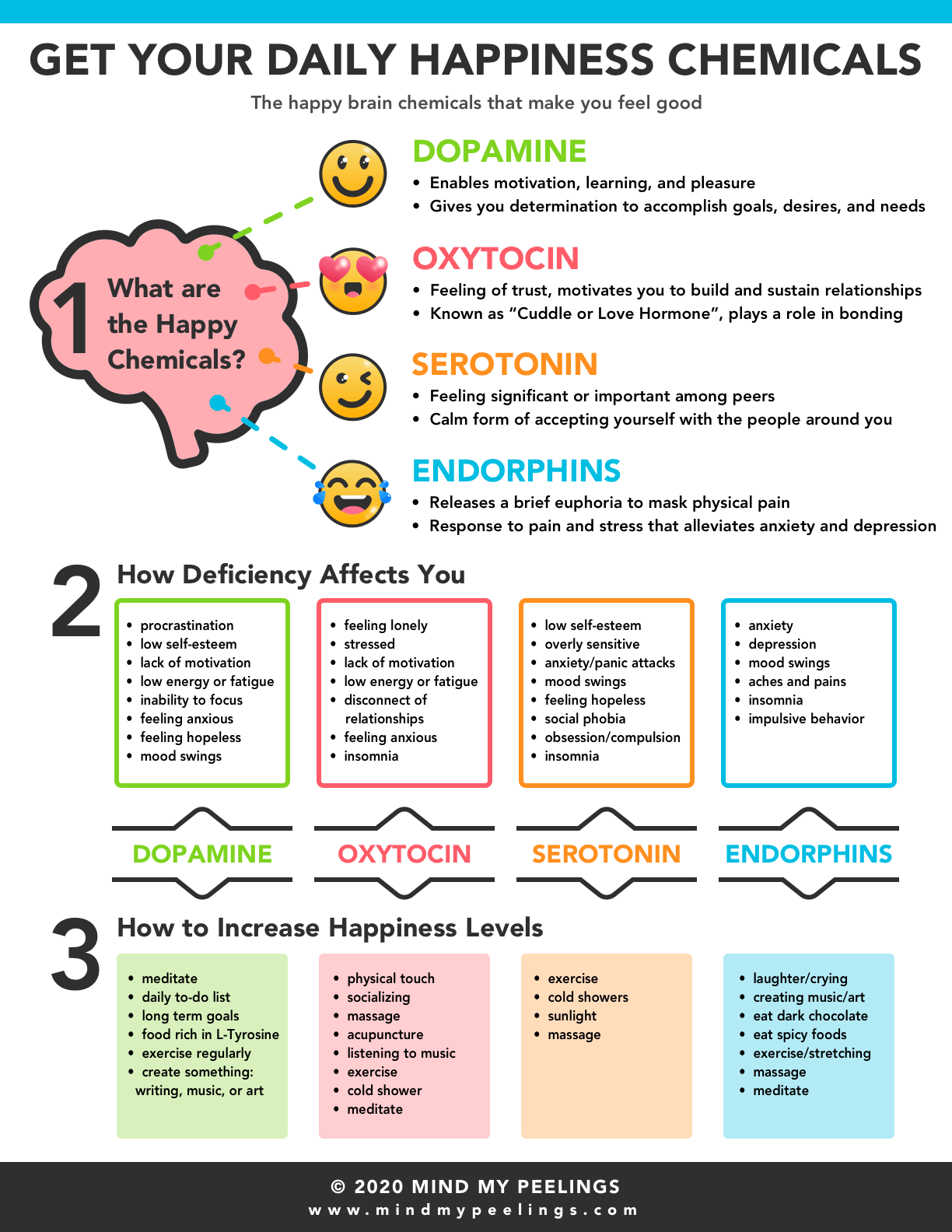The Happy Brain Chemicals that Makes You Feel Good
Did you know, 37% of people around the world are unhappy. That means at least 1 in 3 people you know aren’t happy with their life. Are you one of those people?
If so, there are simple ways to improve your happiness. Have you heard of happiness chemicals? Your brain releases these happy chemicals that make you feel good.
It is common to think happiness is a destination that you have to find either through material items, relationships, or career status. But happiness is the journey and something you can create on your own.
Improving your happiness can be as simple as getting a good night's sleep. It is known that people who are sleep deprived have a harder time remembering positive ideas and an easier time remembering negative ideas.
What are the Happiness Chemicals
When you feel good, your brain is releasing one of the happiness chemicals or happy hormones. There are four main happiness brain chemicals:
Dopamine
Oxytocin
Serotonin
Endorphins
Each chemical has a job to do and when your brain releases one of these chemicals, you feel good.
It would be great if they all surged all the time. However, it does not work this way. Once the chemical has done its job, it will turn off, leaving you with a desire for more.
By understanding how these chemicals work, we can better improve our overall happiness by tapping into each of the four happiness chemicals.
Dopamine
Dopamine enables motivation, learning, and pleasure. It gives you the determination to accomplish goals, desires, and needs.
It’s similar to the, “I got it” feeling when you accomplish something. Once you achieve those goals, desires, or needs, dopamine gives a surge of reinforcing pleasure.
However, the overstimulation of dopamine can become a real problem because of its addictive nature. It is closely tied to developing bad habits or addictions.
The effects of dopamine are fleeting due to its instant gratification feeling, which leaves you desiring more.
Oxytocin
Oxytocin gives a feeling of trust, it motivates you to build intimate relationships and sustain them. It is also known as the “cuddle hormone” or “love hormone” because it plays a role in bonding.
This hormone gives you the desire to stick together with those you “trust”, which creates a feeling of safety or comfort. It helps your body adapt to several different emotional and social situations.
Oxytocin can boost your immune system which makes you more resistant to the addictive qualities of dopamine. Unlike dopamine, oxytocin gives you a lasting feeling of calm and safety.
It can help fight stress, improve relationships, and promote long-lasting positive emotions.
Serotonin
Serotonin rewards you with a good feeling when you feel significant or important. It is the pleasure you get when you experience social power, loyalty, or status.
It results from finding opportunities to assert or prevail. This is not aggressive, rather it is a calm form of confidence and accepting yourself within the people around you.
Serotonin is what motivates a leader to excel and grow. It not only motivates you but your peers to do the same. The feeling of not letting down their leader, parent, or teacher is what causes this motivation.
Endorphin
Endorphins release a brief euphoria that masks physical pain. It is a response to pain and stress which also helps alleviate anxiety and depression. Any kind of physical distress can trigger endorphins.
However, you can also get a release of endorphins when you experience “runners high”. Runners high only occurs when you exceed your limits.
The release of endorphins acts as a natural pain killer and diminishes your perceptions of pain.
The Effects of Happiness Chemicals
At least 1 in 3 people in the world who were surveyed in 2020 were unhappy. That’s a huge portion of the population.
Happiness or lack thereof affects everyone and can contribute to poor overall health. There have been numerous studies linking depression to the reduction of happiness chemicals such as dopamine and serotonin.
One study found people with clinical depression have increased levels of monoamine oxidase A (MAO-A). This is an enzyme that breaks down neurotransmitters.
We will discuss how neurotransmitters play a role in the happiness chemicals later in this article, but simply this means you will get less dopamine or serotonin, thus, less happiness.
This deficiency can lead to various effects that could contribute to mental illnesses like depression.
How Deficiency Affects You
Low levels of happiness chemicals can lead to various symptoms such as fatigue, lack of motivation, and feeling anxious just to name a few.
Here are some of the common symptoms due to the deficiency of the happiness chemicals.
Dopamine Deficiency
procrastination
low self-esteem
lack of motivation or enthusiasm
low energy or fatigue
inability to focus
feeling anxious
feeling hopeless
mood swings
Oxytocin Deficiency
feeling lonely
stressed
lack of motivation or enthusiasm
low energy or fatigue
a feeling of disconnect from your relationships
feeling anxious
insomnia
Serotonin Deficiency
low self-esteem
being overly sensitive and emotional
anxiety and panic attacks
mood swings
depression and feeling hopeless
social phobia
obsessive-compulsive disorders
insomnia
Endorphin Deficiency
anxiety
depression
mood swings
aches and pains
insomnia
impulsive behavior
For those who have difficulty dealing with these symptoms and are feeling stress and overwhelmed, consider taking the window of tolerance self-assessment to identify your symptoms and how to self-regulate.
Benefits of Happiness
Happiness not only plays a role in making you feel good but contributes to:
Improved overall health
improved heart health and lower risk of heart disease
the ability to combat the stress hormone cortisol
stronger immune system so you’re less like to get sick
a healthier lifestyle such as physical activity and sleep habits
can help reduce aches and pain of those with chronic conditions
increase life longevity
Improved creativity and problem-solving skills
Benefiting the community through involvement with charities
Having more positive relationships with those around you
Being able to enjoy life more and get through life challenges easier
Being happy with what you have
How to Increase Happy Brain Chemicals
Most people don’t get enough of each of the happiness chemicals. I know I certainly struggle with this. If you have a full-time job or studies it can be challenging.
This deficiency can make you feel sad, depressed, hopeless, and anxious. Especially those who suffer from depression or experience downward spirals. Thankfully, they’re many simple ways to naturally boost each of the happy brain chemicals.
Below are some of the many natural ways you can get your daily happiness chemicals. Pick a few to start and remember that continuous practice is what makes a difference.
How to Increase Dopamine Levels Naturally
meditate regularly (increases dopamine by 65%)
make a daily to-do list & long term goals (each time you tick off a task or goal you increase dopamine levels)
eat foods that are rich in L-Tyrosine (avocados, fish, eggs, cheese, banana, and pumpkin seeds)
exercise regularly (whichever form of exercise you enjoy the most will give you the most increase in dopamine levels)
create something such as writing, music, art & crafts (“if I create something, I am also creating dopamine”)
How to Increase Oxytocin Levels Naturally
physical touch, cuddling, hugging, making eye contact, and even shaking hands
socializing (connecting or talking with friends and family reduces cortisol and stimulates your vagus nerve)
touching your pet (research shows it lowers blood pressure)
getting a massage (reduces stress hormones)
acupuncture (elevates oxytocin concentrations)
listening to music (has a calming effect on the brain, slow-tempo music has also been shown to increase oxytocin)
exercise (stimulates the vagus nerve)
cold showers (stimulates the vagus nerve)
meditate
How to Increase Serotonin Levels Naturally
exercise (increases serotonin and dopamine, but also helps balance them)
cold showers (2-3 mins of cold showers can be unpleasant but offers great benefits that have longer-lasting effects than compared to caffeine)
sunshine (10-15 minutes of sunlight a day can increase serotonin and vitamin D)
eating foods such as banana, eggs, omega-3 fish, nuts and seeds, leafy greens, and probiotics
getting a massage (increases serotonin and decreases cortisol)
How to Increase Endorphin Levels Naturally
laughter and crying
creating music or art
eating dark chocolate and spicy foods
exercise or stretching
high-intensity interval training
getting a massage
meditate
Getting your daily happy chemicals seems pretty straight forward. But if you are struggling with happiness because you suffer from negative thinking patterns, I recommend learning to challenge negative thoughts first.
Get Your Daily Happiness Chemicals Infographic
Download a copy of the happy brain infographic so you can start improving your happiness today.
These are just some of the many ways you can get your daily happy hormones. If you have some that already work for you, continue doing those. If you don’t try picking a few from the list.
When choosing things that will help increase happiness levels, think about how each of them affects your health. There are three states of health (physical, mental, and social health).
Make sure you choose activities that don’t all contribute to one aspect only. Try to pick a few that can contribute to different aspects so you can reap the full benefits of the happiness chemicals.
If you are unfamiliar with the three aspects of the Health Triangle, I recommend taking the self-assessment first to see which areas you are lacking so you can choose activities that target that aspect.
Overstimulation of the Happiness Chemicals
Ever hear the saying…
“too much of a good thing is a bad thing”
Well, it’s true. Overstimulation of each of the four happiness chemicals in the brain can lead to desensitization.
This in turn leads to an increased desire for those happiness chemicals which creates an addiction cycle. This addiction cycle can affect anyone, especially those who suffer from a mental illness such as depression.
Thankfully, there are ways we can manage or reduce overstimulation. For example, let’s take a look at dopamine as it is commonly known for its addictive nature.
How Dopamine Receptors Work
Dopamine itself is a type of neurotransmitter. The receptor is the receiver of the neurotransmitter. Each type of neurotransmitter has a unique receptor to match it.
To simplify, think of the receptor and neurotransmitter as a lock and key. A specific type of neurotransmitter will only fit into the correct receptor.
Once the dopamine attaches to the dopamine receptor it delivers a chemical message which gives you the effects of the neurotransmitter, in this case, dopamine.
Overstimulation of Dopamine Receptors
If your dopamine receptors are overstimulated, you can become desensitized to the effects of dopamine.
Overstimulation occurs when you experience prolonged periods of dopamine stimulation. This leads to the brain protecting itself by destroying some of the receptors.
Remember, happiness chemicals are only meant to be experienced for a short period before turning off.
Your dopamine levels should remain at an off or low state for some time before being stimulated again. This is a normal up and down experience with dopamine.
However, when you override your natural satiation mechanism by continually feeding yourself dopamine, then Supernormal Stimuli occurs.
This is what happens when you have a normal experience with dopamine versus supernormal stimuli:
The supernormal stimuli is an overstimulation of dopamine which leads to desensitization. This tolerance then encourages us to feed our desire for dopamine even more which creates a cycle of addiction.
Here are some common activities we are all guilty of which leads to overstimulation:
eating fast food regularly
scrolling through social media feeds non-stop
binge-watching your favorite tv show all weekend with little to no breaks
Prevent Overstimulation
Preventing overstimulation can allow your dopamine levels to drop back to a normal level before the next stimulation.
This helps to maintain our sensitization and does not create an addictive attitude towards dopamine. By doing so this will allow you to feel the full effects of dopamine when you experience it.
Here are a few simple ways to prevent overstimulation:
limiting your use by stopping after some time (this allows enough time to drop to a normal level)
limiting the frequency of use (eating fast food once or twice a week versus every day)
not using it like a drug
not using it as an escape mechanism
This is especially important when you have a mental illness such as depression.
The desire to feel better or wanting to escape the pain you experience creates a higher risk for addiction due to the desire for happiness chemicals like dopamine.
Everything in moderation is important to maintain reasonable levels of happiness chemicals.
How to Increase Dopamine Receptors
Overstimulation causes dopamine receptors to be destroyed. Abstaining from the activities that cause overstimulation will allow the number of dopamine receptors to increase.
The increase of dopamine receptors will then increase the effects when dopamine is released. Thus, more happiness!
Here are a few other ways to increase dopamine receptors:
high-intensity interval training is the most effective form of exercise
digital detox (taking time off from technology for a week or two)
cold showers or ice baths
Overstimulation of Happiness Infographic
Download a copy of the overstimulation of happiness chemicals infographic so you can prevent overstimulation today.
Hack Your Happiness Chemicals
To recap, there are four happiness chemicals that your brain releases to make you feel good:
Dopamine: Enables motivation, learning, and pleasure
Oxytocin: Gives you a feeling of trust to build intimate relationships
Serotonin: When you experience social power or confidence in accepting yourself
Endorphin: Brief euphoria to mask physical pain
How to Increase Happy Hormones Naturally:
Understand how deficiency affects you by recognizing what symptoms you may experience
Identify what activities you would enjoy doing to increase happiness
Consistency is key, ensure you are regularly doing those activities
Be aware of overstimulation and abstain from any activities as required
There are plenty of activities that can increase happiness hormones naturally. Choose a few you enjoy, either from the list or ones you already enjoy doing. What’s important is that you enjoy doing it, otherwise it won’t stick.
Remember, we’re looking to achieve long-term happiness so doing an activity once or twice will not make an impact on your lifestyle.
When you are dealing with an existing mental illness, addiction, or trauma, it can be difficult to increase your happiness chemicals.
Consider building up your window of tolerance first to help you deal with the stress, anxiety, or trauma you may have. Then when you come to increasing happiness, it becomes much easier to do.
So what are you waiting for? Print out a copy of the infographic, pick a few activities to start, and you will be on your way to a happier lifestyle.











